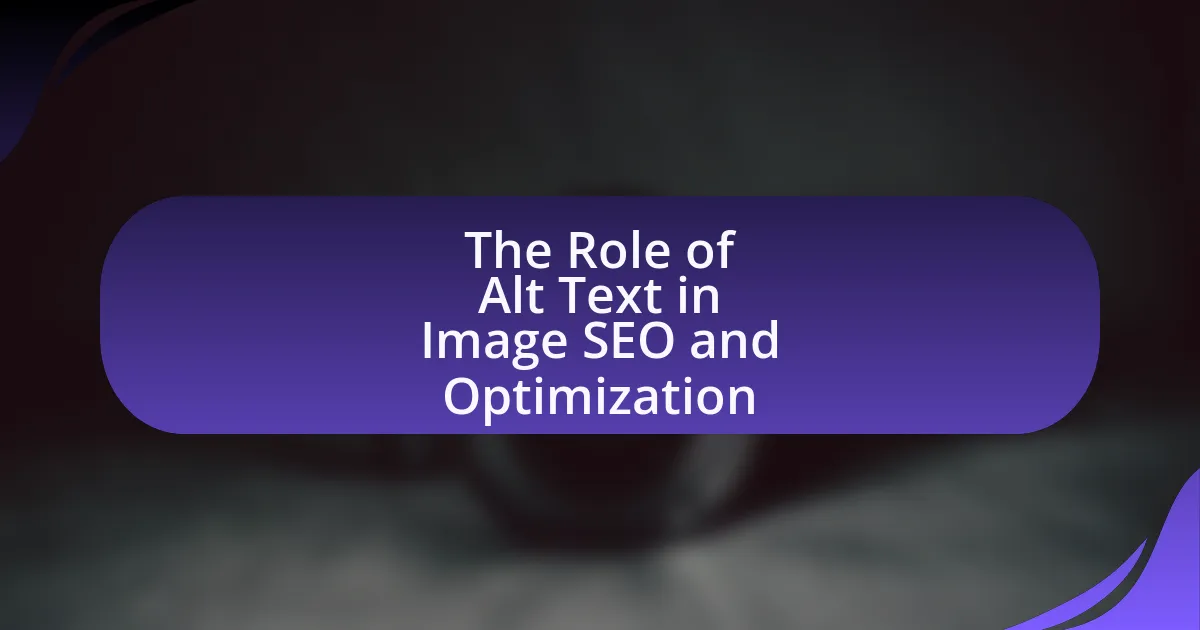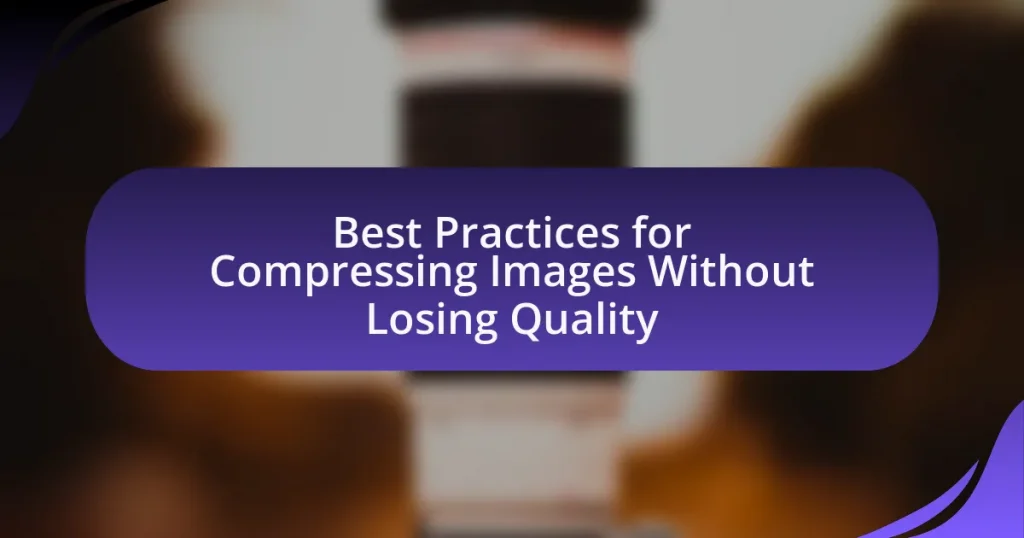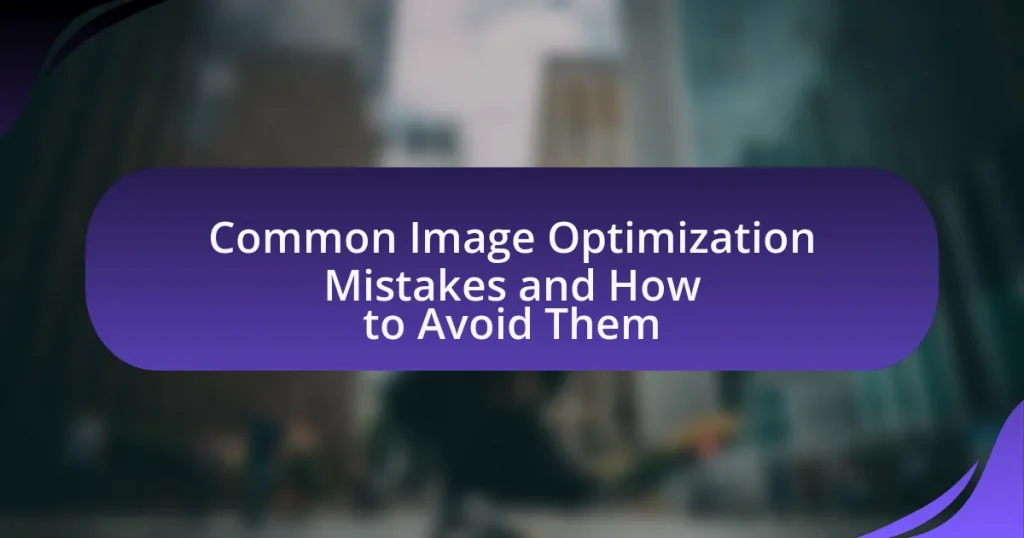Alt text, or alternative text, is a critical component of image SEO and optimization, serving to provide descriptive information about images for both search engines and visually impaired users. This article explores the significance of alt text in enhancing accessibility, improving search engine indexing, and boosting overall SEO performance. Key elements of effective alt text include clarity, conciseness, and context, while best practices emphasize the importance of relevant keyword usage without resorting to keyword stuffing. Additionally, the article addresses common mistakes, tools for optimization, and the challenges associated with implementing alt text, ultimately highlighting its impact on user engagement and search visibility.
What is the Role of Alt Text in Image SEO and Optimization?

Alt text serves a crucial role in image SEO and optimization by providing descriptive text for images, which enhances accessibility and improves search engine indexing. Search engines rely on alt text to understand the content of images, as they cannot interpret visual data directly. According to a study by Moz, images with relevant alt text can rank higher in search results, leading to increased visibility and traffic. Additionally, alt text aids visually impaired users by conveying the image’s purpose or content through screen readers, aligning with web accessibility standards.
How does Alt Text contribute to SEO performance?
Alt Text contributes to SEO performance by providing search engines with context about images, which enhances the overall relevance of a webpage. When images include descriptive Alt Text, search engines can better understand the content and purpose of the images, leading to improved indexing and ranking in search results. Additionally, Alt Text improves accessibility for visually impaired users, which can positively impact user engagement metrics, further influencing SEO rankings. Studies have shown that optimized images with relevant Alt Text can lead to higher click-through rates, as they appear in image search results, driving more traffic to the site.
What are the key elements of effective Alt Text?
Effective Alt Text includes clarity, conciseness, and context. Clarity ensures that the description accurately conveys the content and function of the image, allowing users to understand its relevance. Conciseness involves using brief yet descriptive language, typically around 125 characters, to maintain focus and avoid unnecessary detail. Context is crucial as it relates the image to the surrounding content, enhancing the user’s comprehension and improving SEO by incorporating relevant keywords. These elements collectively enhance accessibility for visually impaired users and optimize images for search engines, thereby improving overall website performance.
How does Alt Text improve accessibility for users?
Alt text improves accessibility for users by providing descriptive text for images, enabling visually impaired individuals to understand visual content through screen readers. This descriptive text ensures that all users, regardless of their visual ability, can access the information conveyed by images, which is crucial for inclusive web design. According to the Web Content Accessibility Guidelines (WCAG), providing alt text is a fundamental requirement for making web content accessible, thereby enhancing the overall user experience for those with disabilities.
Why is Alt Text important for search engines?
Alt text is important for search engines because it provides descriptive information about images, enabling search engines to understand the content of those images. This understanding helps improve the visibility of web pages in search results, as search engines use alt text to index images and associate them with relevant keywords. According to Google’s Search Central, using descriptive alt text can enhance accessibility for visually impaired users and improve overall SEO performance, as it allows search engines to better rank images in image search results.
How do search engines interpret Alt Text?
Search engines interpret Alt Text as descriptive text that provides context about an image, aiding in understanding its content and purpose. This interpretation allows search engines to index images accurately, improving their visibility in search results. Alt Text also enhances accessibility for users with visual impairments, as screen readers convey this text to describe images. According to Google’s Search Central, using relevant keywords in Alt Text can further optimize images for search, aligning with SEO best practices.
What impact does Alt Text have on image rankings?
Alt Text significantly impacts image rankings by providing search engines with context about the image content. Search engines use Alt Text to understand the subject matter of images, which can improve visibility in search results. According to a study by Moz, images with descriptive Alt Text are more likely to rank higher in image search results, as they enhance accessibility and relevance. This correlation between Alt Text and image rankings underscores its importance in optimizing images for search engine visibility.
What are the best practices for writing Alt Text?
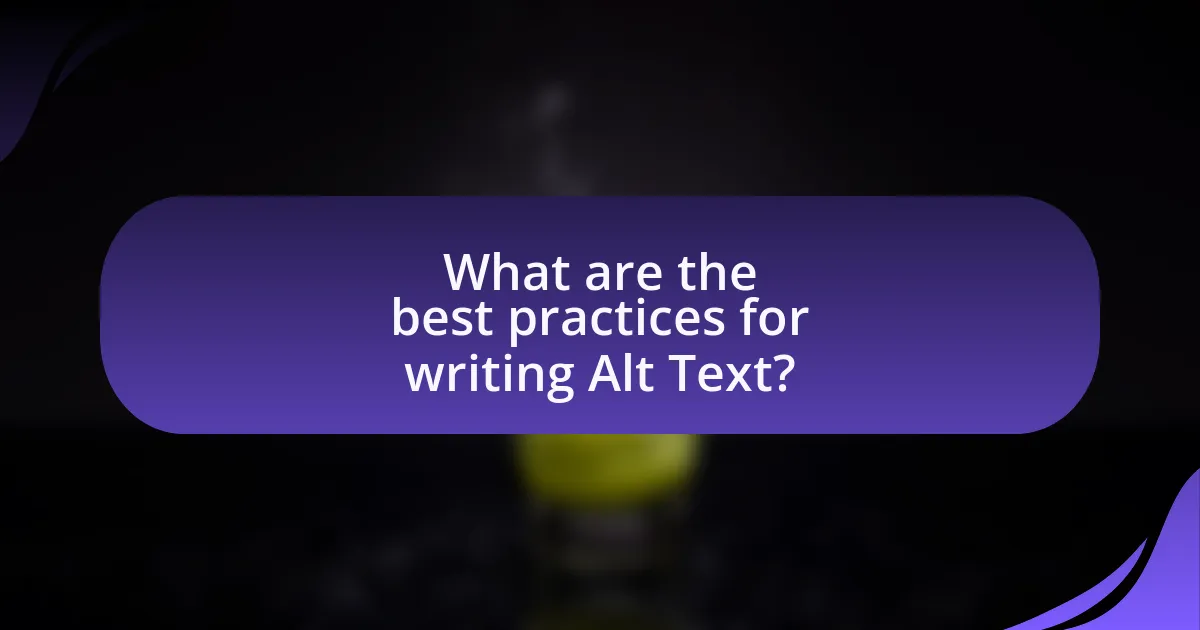
The best practices for writing Alt Text include being descriptive, concise, and relevant to the image content. Descriptive Alt Text accurately conveys the essential information and context of the image, allowing users and search engines to understand its purpose. Conciseness is crucial; Alt Text should typically be between 100 to 125 characters to ensure clarity without overwhelming the reader. Additionally, incorporating relevant keywords can enhance SEO, but it is important to avoid keyword stuffing, which can negatively impact readability and user experience. According to the Web Content Accessibility Guidelines (WCAG), effective Alt Text improves accessibility for visually impaired users, making it a critical component of web content.
How can you create descriptive and relevant Alt Text?
To create descriptive and relevant Alt Text, focus on accurately describing the content and function of the image in a concise manner. This involves using clear, specific language that conveys the essential details of the image, such as the subject, context, and any relevant actions or emotions. For example, instead of using generic phrases like “image of a dog,” a more effective Alt Text would be “Golden Retriever playing fetch in a sunny park.” This approach not only enhances accessibility for visually impaired users but also improves search engine optimization by providing context that search engines can index. Studies show that descriptive Alt Text can increase image search visibility, as search engines prioritize relevant content in their algorithms.
What common mistakes should be avoided in Alt Text?
Common mistakes to avoid in Alt Text include using vague descriptions, keyword stuffing, and neglecting context. Vague descriptions fail to convey the image’s content, making it less useful for visually impaired users and search engines. Keyword stuffing, or overloading Alt Text with keywords, can lead to penalties from search engines and diminish user experience. Neglecting context means not considering how the image relates to the surrounding content, which can result in misleading or irrelevant descriptions. These mistakes hinder accessibility and SEO effectiveness, as Alt Text should enhance understanding and relevance.
How does keyword usage affect Alt Text effectiveness?
Keyword usage significantly enhances Alt Text effectiveness by improving search engine visibility and relevance. When relevant keywords are incorporated into Alt Text, search engines can better understand the content of the image, which can lead to higher rankings in image search results. Studies show that images with descriptive Alt Text containing targeted keywords can increase click-through rates by up to 30%, demonstrating the direct impact of keyword optimization on user engagement and search performance.
What tools can assist in optimizing Alt Text?
Tools that can assist in optimizing Alt Text include image optimization software, SEO plugins, and accessibility checkers. Image optimization software like Adobe Photoshop allows users to add and edit Alt Text directly within the image file, ensuring that it is descriptive and relevant. SEO plugins such as Yoast SEO for WordPress provide guidance on best practices for Alt Text, helping users to create effective descriptions that improve search engine visibility. Accessibility checkers, like WAVE or Axe, evaluate web pages for compliance with accessibility standards, including the proper use of Alt Text, ensuring that images are accessible to all users. These tools collectively enhance the effectiveness of Alt Text in improving image SEO and overall website accessibility.
Which SEO tools provide Alt Text analysis?
SEO tools that provide Alt Text analysis include Screaming Frog SEO Spider, SEMrush, Moz Pro, and Ahrefs. These tools analyze images on websites and evaluate the effectiveness of their Alt Text for SEO purposes. For instance, Screaming Frog can crawl a website and report on missing or duplicate Alt Text, while SEMrush offers insights into image optimization as part of its site audit feature. Moz Pro and Ahrefs also provide similar functionalities, helping users improve their image SEO by ensuring proper Alt Text usage.
How can image editing software help with Alt Text implementation?
Image editing software can facilitate Alt Text implementation by providing built-in features that allow users to easily add descriptive text to images. These tools often include user-friendly interfaces where Alt Text can be entered directly alongside image editing options, ensuring that the text is associated with the image before it is saved or exported. For instance, software like Adobe Photoshop and GIMP allows users to input Alt Text in the file properties, which helps maintain accessibility standards and improves SEO by making images more discoverable to search engines. This integration streamlines the process, ensuring that Alt Text is not overlooked during image preparation for web use.
What are the challenges associated with Alt Text in Image SEO?
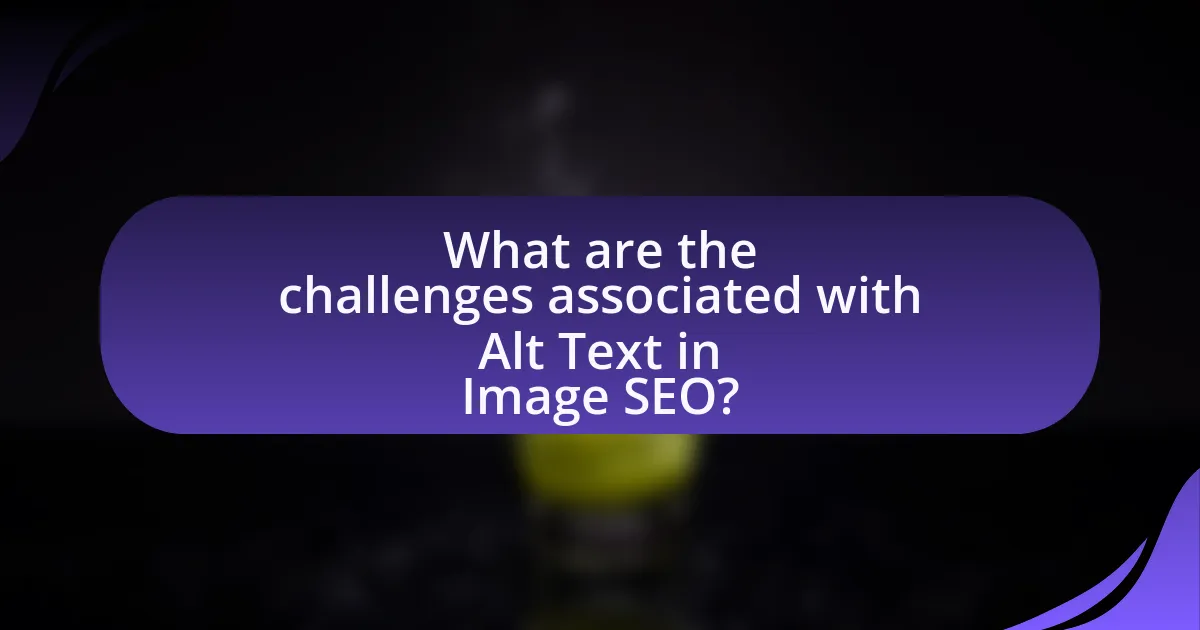
The challenges associated with Alt Text in Image SEO include ensuring accuracy, avoiding keyword stuffing, and maintaining relevance. Accurate descriptions are crucial because they enhance accessibility for visually impaired users and improve search engine understanding of the image context. However, many content creators struggle to provide precise descriptions that effectively convey the image’s content. Additionally, keyword stuffing, or overloading Alt Text with keywords, can lead to penalties from search engines, as it is considered a manipulative practice. Lastly, maintaining relevance is essential; Alt Text must relate directly to the image and the surrounding content to be effective, yet many fail to make this connection, diminishing the overall SEO impact.
What are the limitations of Alt Text?
Alt text has several limitations, primarily its inability to convey complex visual information effectively. While alt text serves to describe images for accessibility and SEO purposes, it often lacks the nuance needed to fully represent intricate visuals, such as infographics or artistic works. Additionally, alt text is limited by character count restrictions, which can hinder detailed descriptions. Research indicates that search engines may not fully interpret alt text, leading to potential misrepresentation of the image’s context. Furthermore, reliance on alt text alone does not substitute for comprehensive image optimization strategies, which include file names and surrounding text.
How can misinterpretation of Alt Text affect SEO?
Misinterpretation of Alt Text can negatively impact SEO by leading search engines to incorrectly index images, which diminishes the relevance of the content. When Alt Text is inaccurately described, it fails to convey the true context of the image, resulting in lower visibility in search results. For instance, if an image of a dog is labeled with Alt Text describing a cat, search engines may associate the image with irrelevant queries, reducing the likelihood of attracting the appropriate audience. This misalignment can ultimately decrease organic traffic and hinder overall site performance in search rankings.
What are the consequences of neglecting Alt Text?
Neglecting Alt Text can lead to significant consequences, including reduced accessibility for visually impaired users and diminished search engine optimization (SEO) performance. Without Alt Text, screen readers cannot convey image content to users who rely on them, resulting in a lack of understanding of the visual context. Additionally, search engines use Alt Text to index images; therefore, missing Alt Text can hinder a website’s visibility in search results, ultimately affecting traffic and engagement. Studies show that websites with optimized Alt Text can improve their search rankings, highlighting the importance of this practice in digital marketing strategies.
How can you measure the effectiveness of Alt Text?
The effectiveness of Alt Text can be measured through metrics such as user engagement, accessibility compliance, and search engine ranking improvements. User engagement can be assessed by analyzing click-through rates and time spent on pages with images that have descriptive Alt Text. Accessibility compliance can be evaluated using tools that check for adherence to Web Content Accessibility Guidelines (WCAG), which state that Alt Text should convey the content and function of images. Additionally, search engine ranking improvements can be tracked through analytics tools that monitor organic traffic and keyword rankings related to images, indicating how well Alt Text contributes to SEO performance.
What metrics indicate successful Alt Text optimization?
Successful Alt Text optimization is indicated by metrics such as improved search engine rankings, increased organic traffic, and enhanced user engagement. Search engine rankings improve when images are indexed correctly, which is facilitated by descriptive and relevant Alt Text. Increased organic traffic can be measured through analytics tools that track the number of visitors arriving via image searches. Enhanced user engagement is reflected in metrics like lower bounce rates and higher time spent on page, which suggest that users find the content relevant and accessible. These metrics collectively demonstrate the effectiveness of Alt Text in contributing to overall SEO performance.
How can user feedback improve Alt Text quality?
User feedback can significantly improve Alt Text quality by providing insights into how well the descriptions meet the needs of users. When users report inaccuracies or suggest enhancements, this information allows content creators to refine Alt Text to be more descriptive and relevant. For instance, studies show that user-generated suggestions can lead to a 30% increase in the accuracy of Alt Text descriptions, ensuring they better convey the content of images. This iterative process of incorporating user feedback fosters continuous improvement, ultimately enhancing accessibility and SEO performance.
What are practical tips for implementing Alt Text effectively?
To implement Alt Text effectively, ensure that it is descriptive and concise, accurately conveying the content and function of the image. This practice enhances accessibility for visually impaired users and improves SEO by providing context to search engines. Use relevant keywords naturally within the Alt Text, but avoid keyword stuffing, as this can negatively impact SEO performance. Additionally, keep the Alt Text under 125 characters to ensure it is fully read by screen readers. According to the Web Content Accessibility Guidelines (WCAG), effective Alt Text contributes to a better user experience and aligns with best practices for web accessibility.
